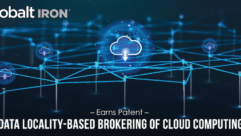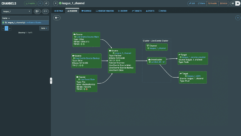

Cloud Computing
Nov 18, 2011 11:45 AM,
By Mark Mayfield
Is it ready for AV control?
Is AV ready for cloud computing?
The definition of cloud computing has, until recently, been as translucent as the gaseous cluster of water vapor molecules after which it is named.
To help add shape to the issue, the National Institute of Standards and Technology (NIST) released a draft document in January 2011, titled “The NIST Definition of Cloud Computing.” It begins with the definition: “Cloud computing is a model for enabling ubiquitous, convenient, on-demand network access to a shared pool of configurable computing resources (e.g., networks, servers, storage, applications, and services) that can be rapidly provisioned and released with minimal management effort or service provider interaction.”
As part of its definition, NIST also defines three service models, including Software as a Service (SaaS), Platform as a Service (PaaS), and Infrastructure as a Service (IaaS). Saas is the capability to use the provider’s applications running on a cloud infrastructure, where the applications are accessible from various client devices through a thin client interface such as a web browser (e.g., web-based email). Platform as a Service (PaaS) refers to the capability to deploy onto the cloud infrastructure consumer-created or acquired applications created using programming languages and tools supported by the provider. Cloud Infrastructure as a Service (IaaS) allows the capability to provision processing, storage, networks, and other fundamental computing resources where the consumer is able to deploy and run arbitrary software, which can include operating systems and applications. The consumer does not manage or control the underlying cloud infrastructure but has control over operating systems, storage, deployed applications, and possibly limited control of select networking components (e.g., host firewalls).
In the IT world, cloud computing is here today, and most experts predict significant expansion. Gartner is projecting rapid growth in public cloud services worldwide, with revenue growing from $68.3 billion in 2010 to $102.1 billion by 2012 and $180 billion by 2015. Somewhat more conservatively, IDC predicts that public cloud IT spending will grow from $21.5 billion in 2010 to $72.9 billion in 2015. While Gartner focuses on revenue, which allows for the inclusion of new business model growth, both firms expect the cloud market to grow at more than five times the rate of traditional IT products.
But is AV going to the cloud? It depends on whom you ask. Many would say that it already has. Any time you access music, video or other AV content that’s hosted on a server that you don’t own, that’s cloud AV access. Cloud AV is already well entrenched in the consumer AV world. Do you use Netflix? That’s cloud-based AV access. So is YouTube.

A cloud-based AV control system uses software installed on a network server, which is accessible anywhere on the network. Illustration courtesy of Cloud Systems
Apple’s iCloud allows users to stream images and other types of media to other devices, primarily manufactured from Apple. And Amazon’s Cloud Player is all about storage and streaming of music—all you do is “reserve” as much cloud storage as you need.
But what about cloud-based AV control for out-of-the-home applications? If the current trend of consumer technologies migrating to commercial applications continues, it’s probably already on its way.
“Today, I can control devices in my home today over the cloud, using my iPhone or iPad,” says Dave Sobel, CEO of Fairfax, Va.-based Evolve Technologies. “As commercial AV moves closer to the IT model, it’s only logical that this type of control will extend to AV systems in the workplace.” Sobel cites figures from CompTIA, which projects that 20 percent of businesses will have fully cloud-based IT services by the end of 2012. It’s no big stretch to envision that commercial AV devices and systems—already considered part of the IT infrastructure—aren’t far behind.
Not everyone agrees with Sobel’s assessment, including Steve Greenblatt, president of independent programming firm Control Concepts. “At this point, I think it’s pretty far off,” he says. “A lot of people had been thinking, for years, that you wouldn’t need anything more than a computer in a room to control an AV system, but AV systems have really gotten a lot more complicated than that. I think cloud-based control would be some time in the future.”
One of the problems with the idea of cloud-based AV control is that, for many AV devices, you still need a dedicated control processor to perform basic functions, like projector on/off, audio system volume levels, or camera pan/tilt/zoom. Serial commands delivered by IR or RS-232 and simple contact closure signal is still the most common way to control many AV products. But most control processors today are software-configurable, so it’s logical that as these devices become more like IT appliances, the software that drives control functions could be accessed via the cloud.
AMX has announced a cloud-based systems configuration tool that allows AV technicians or IT professionals to easily configure an AMX system by using a step-by-step, wizard-based approach. Rapid Project Maker (RPM) is stored on AMX servers, so users never have to worry about “who owns the code” or what happens if an on-premise system should fail. It’s always there, “in the cloud”; no additional software is required. Once configuration of an AV control system is complete, the code is downloaded to the on-premise controller, and it’s ready to go. But just as configuration moves to the cloud, is it feasible that the control processor itself could disappear as an on-premises piece of hardware, and become a cloud-based IaaS function?
Cloud Computing
Nov 18, 2011 11:45 AM,
By Mark Mayfield
Is it ready for AV control?
That’s what Oakland, Calif.-based Cloud Systems is betting on. “We are completely independent of hardware-based AV control systems,” says Cloud’s chief finance and operating officer Cheryl Blain. One of the company’s core products, atmospherics 2.3, is a software-based tool that allows network administrators to take control of any IP-addressable device, anywhere on their network, without a dedicated AV control processor.
“A deployment would involve taking the licensed atmospherics software, installing it on a server, and configuring it through the administrator interface. Just add the devices you want to control. It’s a simple as adding a printer to your network.” The company creates and provides drivers for many AV devices to work with several different interfaces that are already part of the enterprise landscape, including the Cisco Cius tablet and the Cisco IP phone. In addition, you can access atmospherics from any web browser.
Cloud-based AV control has several hurdles to overcome before it can become mainstream. Device driver availability (does a driver exist?) and network access for AV devices (does it have an Ethernet port?) are two issues. A third issue may be more thorny: acceptance of the idea of less hardware, more software. In the IT world, this issue is all but resolved. But the business model of most traditional AV integrators and manufacturers is built on hardware-based, on premise systems.
Technology managers looking to move to a more cloud-based AV and IT infrastructure should carefully explore the “as a Service” intentions of their AV suppliers.

Getting Your Customers Up to Speed
The more your customers know, the better you can serve them. This is especially true when it comes to the emerging and often misunderstood topic of IP-based control of AV systems. With computers and IP-based workflows proliferating in the working world, it is easy for end-users to make assumptions about how AV and IT can or should work together. But controlling AV is not the same as browsing the Web or using an iPhone, no matter how much user interface design suggests that with look and feel.
The Technology Manager’s Guide to IP-based AV Control is an essential primer for end-users and tech managers looking to increasetheir understanding of IP-based controland how it can impact a facility’s budget. Thisguide, from our sister publication AV Technology,covers a group of introductory topics onthe intersection of AV and IT.
The guide explains the origins of IP, with a brief history that helps explain why the transition of IP protocols to AV is a challenge, covering the common protocols including TCP, UDP, IP, ICMP, and DHCP and the differences between IP control vs. IP signal delivery.
Author Tim Kreidel digs into specifics for the AV industry with a detailed discussion of current offerings in IP-based control, the pros and cons and user interfaces, as well as a breakdown of common types of control signals including RS-232C, RS-422, RS-485, RF, wired and wireless RI, and variable voltage and mechanical contact closures.
The guide also includes a definitive comparison chart of current IP-based control solutions from companies including Altinex, AMX, Barix, Bitlogix, Calypso, ClearOne, Cloud Systems, Crestron, Extron, FSR, Global Cache, High Resolution Systems, NetStreams, Pivod Technologies, SP Controls, and Vity Technology.
The helpful tutorial discusses how to verify an IP address. The guide contains key insights from Evolve Technologies’ Dave Sobel and Control Concepts’ Steve Greenblatt. Read the pros and cons of IP control of AV and consider sharing this resource with your customers. Download this free guide.
Sources: Trends in Cloud Computing 2011, published by CompTIA, and National Institute of Standards and Technology.










